Stephen Jeffries King
Inductee to Hall Of Fame 2013
Veterinarian Stephen Jeffries King has had an amazing association with Greyhound Racing in Tasmania generally, but in Launceston particularly, spanning almost fifty years. Whether in his role as L.G.R.C. veterinary surgeon, Tasmanian Greyhound Board member, Tasmanian Racing Authority representative, or Club sponsor, he has been a highly popular and admired friend of Greyhound Racing in this State.
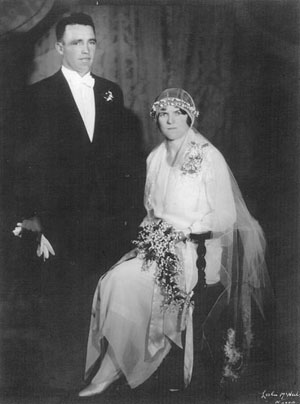
Stephen King’s parents, James and Rebecca
Born in Wagga Wagga on December 28 1936, he was the fourth son of James and Rebecca King, residents of the small village of Currawarna, twenty one miles from Wagga on the Murrrumbidgee River. He was named Stephen, according to his Mother, after her doctor Stephen Weedon (father of James Packer’s mother), or, according to his Father, after bushranger Ned Kelly’s good mate Stephen Hart, the Kelly gang coming from the Greta/ Morhu area where his father grew up. Stephen’s grandfather had arrived as a Protestant free settler in 1841, and through the advent of rather large families, the King clan were spread all over South Eastern Australia.
Growing up, Stephen and his brothers helped his mother run the family dairy, as his father was working at Uranquinty Aerodrome, and was only home weekends. Mainly with brother Jim, it was get up, catch the horse, find the cows, milk them (initially by hand), feed the calves and pigs, then get dressed and ride the horse to the one room Currawarna School, a mile away. Along with chasing rabbits and selling the skins, it was a hard and busy life, but in Steve’s words “still life was great”.
Despite a limited education, Stephen’s mother, a devout Anglican, was an intelligent, well read woman, who demanded all four sons would be afforded a proper education. Attending Wagga Wagga High School became pretty interesting in 1949, as the six stone Stephen and brother Jim, had to board in Wagga on week days, and ride their Malvern Stars 21 miles between the farm and school Mondays and Fridays; quite daunting in mid-winter.
At age 13, he was enrolled in the “boys only” Yanco Agricultural High School in the Murumbidgee. A fierce determination grew from severe bullying, and Stephen not only excelled in various sports, but achieved honours in Agriculture and Science, affording him a Commonwealth Scholarship to study Veterinary Science at Sydney University in 1954. From 1955 until graduation, he lived at the Church Of England College, a stone’s throw from Harold Park Trotting and Greyhounds, and even closer to an SP bookie!
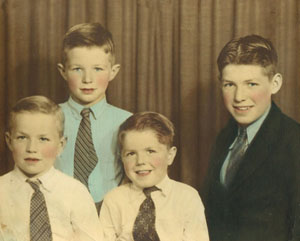
Stephen, front left, with his brothers
After cruising through the first two years, Stephen failed third year, for three reasons ” I did not study enough, spent too much time following the races, and my father died”. Coming from a serious gambling family on his paternal line, he was first cousin to famous gambler “Melbourne Mick” Bartley.
In this year, Steve King and fellow student Barry Gilbo, (to become Doctor and lifelong friend) secured a regular weekend job with the Australian Jockey Club Swab team. Missing very few weekends, and too many midweek meetings, and on the decent pay of three pounds and three shillings, the distractions were high and betting opportunities very tempting with this new found galaxy of racing. Stephen recalls the joy of spending time around such greats as Tommy Smith, Maurice McCarten and Sutton McMillan, and being in the swab box with freak gallopers such as Tulloch and Todman.
But failing Third Year brought this life to a sudden halt. Steve had no scholarship, and no funds from a widowed mother, so he contacted all State Government Agricultural Divisions to pursue his course. The Tasmanian Government agreed to pay his fees, and pay an allowance to complete his course, provided he would work for the Department for four years. A determined Stephen King flawlessly completed his final three years of study, and graduated in 1959.
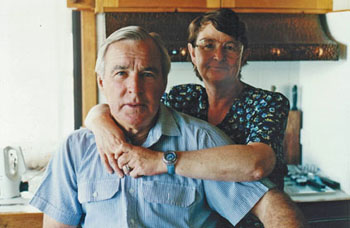
Stephen King and first wife Edith (nee Shannon)
After graduation, Stephen became engaged to Edith Shannon, and they headed back to Tassie where he commenced work on February 29 1960. The pair were married in Sydney on June 13 1960, a marriage that bore three children, David born 1963, John born 1965 and Catherine(Kate) born 1982.
After a brief stint as a Locum on King Island, Stephen King commenced as a Junior Veterinary Pathologist at the new Veterinary and Agronomy Laboratories at Mt.Pleasant. After eighteen months, Stephen was the lone pathologist at the highly acclaimed lab, but received wonderful support from talented bacteriologist Arthur Corbould and Senior Technician Les Blair.
Despite loving pathology, Stephen’s desire to commence private practise was greater, and he left the Department on February 29 1964. After a three month stint in Hobart, working with Joe Laskey, Stephen and Edith made a happy return to Launceston, where they set up their own private veterinary practise on July 1 1964, in an old bank, one removed from the corner of Wellington and Thistle Streets. His Launceston Veterinary Hospital relocated to 351 Wellington Street in February 1965 and is still there nearly forty nine years later.
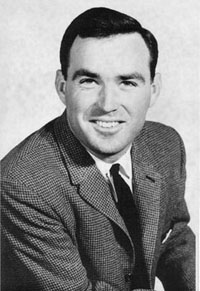
A young and dapper Stephen King
Private practise went very well and his first assistant Dr. Lynne Terry (later Lynne Tilt) whose father Roy trained some very good greyhounds, never left the business. Stephen commenced as Launceston Greyhound Racing Club veterinarian in August 1964, one month after commencing private practise. Ray Foley was Club Secretary and Ollie Illingworth was Senior Steward. Both those men are in our Hall Of Fame. Stephen King’s practise is still the L.G.R.C Vet, nearly a half century on. He took over these duties from former Mt. Pleasant pathologists Barry Munday and Graeme Gregory.
Whilst never chasing post race veterinary examinations, ” leaving it to the experts and the Dr. Harrys”, Stephen King has been associated with every aspect of greyhound care, and his name is synonymous with greyhound racing in this State. He prides his practise on the finest surgery such as orthopaedics, caesareans, and the like.
He was an early and fierce supporter of the drive for parvo vaccinations, so important in our quality of rearing. His reputation was building right from the earliest days, with the June 1968 copy of The Greyhound Monthly News Editorial stating: ” for many years there has been a lack of veterinarians in Launceston. This position has been alleviated in the past couple of years by the advent of Stephen King (B.V.Sc.), who by ability and willingness to work long hours, has set up a flourishing practise.” It would be safe to say, that greyhound people state wide have the same opinion many decades on.
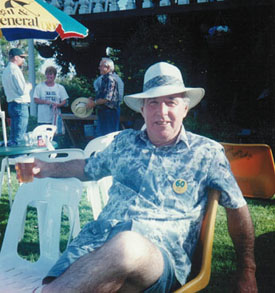
Celebrating his sixtieth birthday
In 1969 Stephen’s practise took over all Northern greyhound identification and ear branding from Percy Campton, who later became the senior steward. After several decades, these duties are now shared with another practise.
Stephen King doesn’t believe there has been a massive change in the physical treatment of greyhounds over the years, with trainers now more aware of their own treatment, and learning from some of the outstanding “muscle men”. Stephen considered the great trainer Charlie Peoples, as one of his early mentors in the 1960’s.
Apart from his dedication to the all matters veterinary, Stephen King has been of great service to Tasmanian Greyhound racing in other areas. He spent upwards of four years on the Tasmanian Greyhound Racing Board, at the invitation of then Racing Minister Harry Holgate. Further, he represented greyhounds on the Tasmanian Racing Authority along with John Kable, David Peters and Lloyd Whish Wilson
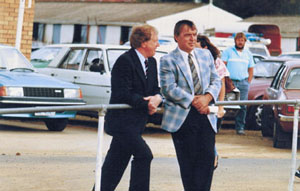
Stephen (right) with former Labor Racing Minister Harry Holgate
Stephen King’s Practise also provides the on course vet for Launceston Harness meetings. In the 1970’s, Stephen co- built a Harness Racing Stud and Stable at Pipers River, before jointly buying Tasman Lodge Stud, where the successful stallion Atashy stood, which he and his partners had purchased from the U.S.A. Stephen also set up a satellite Veterinary Clinic at Longford, which he sold in the late 1990’s, to his assistant of six years and close family friend Michael Morris, now the State’s leading Thoroughbred Vet. Why Harness racing? Because at that time, Pacing was leading the way, with Thoroughbreds struggling. In Stephen’s own words ” little did I know, fifty years later, …Greyhounds would be showing the way, with low cost, consistent programmes , not requiring expensive track maintenance”.
A Veterinary Surgery that started with just one man, now has eight Veterinary practitioners. Not only has Stephen King serviced Northern Tasmania for all of that time, but Lynne Tilt has worked there for forty three years, and Kim Barrett thirty three years. Such loyalty speaks volumes of the man himself, whom the L.G.R.C. made a Life Member many years back. Kim Barratt’s great service to the Launceston Club was also rewarded with Life Membership. Kim proudly talks of Steve King’s huge work ethic, and stands out others qualities such as innovative and generous. Many greyhound people would have noted the Stephen King generosity in hard times. Also, for many years Stephen King’s practise has sponsored the Launceston Breeders Classic, very fitting for someone who has long supported breeding and the need for breeder’s incentives.
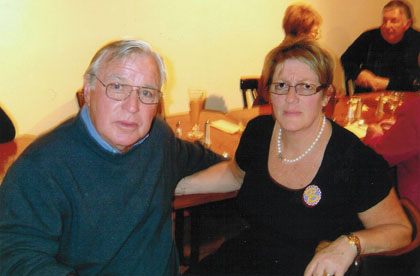
Stephen King and wife Cheryl (nee Holyman)
Stephen lost his wife Edith on June 18 2005, after forty five years together. He is now married to Cheryl Crosby (nee Holyman).
Stephen King is one of the most recognisable names in greyhound racing in Tasmania. As a person considered to be of significant community worth, he was honoured with carrying the Olympic Torch in Launceston 1999, prior to the 2000 Sydney Olympics. He is a humble and popular figure, and has given so much to our sport, in such a wide variety of areas, spanning nearly half a century. We honour that service with his induction into the Tasmanian Greyhound Hall of Fame.

0 Comments